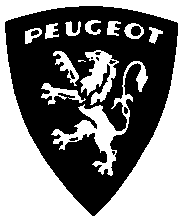PEUGEOT

W 1810 r. brothers Jean Frederick and Jean Pierre Peugeot founded a small steel foundry in Sous-Cretet, which became the foundation of the later family business. W 1885 r. the third generation of the Peugeot family, bracia Eugene and Armand, began to consider transforming the plant, at that time producing bicycles and steam tricycles, into a car factory. Armand Peugeot rightly predicted, that the predominant steam drive at that time had no development prospects and began to switch to gasoline engines. W 1888 r. concluded an agreement with the company Panhard & Levassor for the supply of Daimler licensed engines, and two years later, the first Peugeot with vis-a-vis seats and a 2-cylinder Daimler engine left the factory gates. A car equipped with a gearbox developed speed 25 km/h. In the cycling race Paris - Brest - Paris served as a companion car and a length route 2047 km traveled at an average speed 14,7 km/h. In 1894. during the famous Paris-Rouen drive, as many as five Peugeot cars achieved great success, reaching the finish line and thus fulfilling the conditions of that endurance competition. Peugeot together with Levassor shared the first prize in the amount of 5000 gold francs, sponsored by the journal "Petit Journal”.
W 1895 r. the first world car race took place on the Paris - Bordeaux - Paris route. At the start of a difficult route, counting 1200 km, it stopped 21 vehicles, Panhard among them & Levassor, DeDion, Benz, Bollee and of course Peugeot. After Levassor's disqualification, Koechlin in Peugeot became the winner. A special Peugeot car, called L'eclaire, also took part in the race, equipped with the latest hit - Michelin tires, whose creator personally drove the car and repaired defects.
Following the successes in racing, the number of orders for Peugeot cars increased and their production increased. W 1896 r. Armand Peugeot established an independent car factory in Audincourt - Societe des Automobile Peugeot. In racing, organized in the period preceding the First World War, his cars continued to lead the way. All the innovative technical solutions proven in competitions appeared in the next year in mass-produced cars. Brakes for all 4 Peugeot cars wheels received w 1914 r.
The Bebe model should be mentioned from the wide range of series-produced cars, by Ettore Bugatti, Quadrilette z 1920r. with electric starter and lighting and Cyclecar z 1921 r. by weight 345 kg and fuel consumption 6 liters per 100 km.
The company owes its success to the proverbial solidity of cars and beautiful lines of the body, which is the result of cooperation with the famous Italian bodywork company - Pinin Farina.